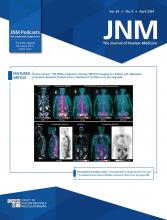Abstract
Because the clinical course of low-grade gliomas in the individual adult patient varies considerably and is unpredictable, we investigated the prognostic value of dynamic 18F-fluorethyltyrosine (18F-FET) PET in the early diagnosis of astrocytic low-grade glioma (World Health Organization grade II). Methods: Fifty-nine patients with newly diagnosed low-grade glioma and dynamic 18F-FET PET before histopathologic assessment were retrospectively investigated. 18F-FET PET analysis comprised a qualitative visual classification of lesions; assessment of the semiquantitative parameters maximal, mean, and total standardized uptake value as ratio to background and biologic tumor volume; and dynamic analysis of intratumoral 18F-FET uptake over time (increasing vs. decreasing time–activity curves). The correlation between PET parameters and progression-free survival, overall survival, and time to malignant transformation was investigated. Results: 18F-FET uptake greater than the background level was found in 34 of 59 tumors. Dynamic 18F-FET uptake analysis was available for 30 of these 34 patients. Increasing and decreasing time–activity curves were found in 18 and 12 patients, respectively. Neither the qualitative factor presence or absence of 18F-FET uptake nor any of the semiquantitative uptake parameters significantly influenced clinical outcome. In contrast, decreasing time–activity curves in the kinetic analysis were highly prognostic for shorter progression-free survival and time to malignant transformation (P < 0.001). Conclusion: Absence of 18F-FET uptake in newly diagnosed astrocytic low-grade glioma does not generally indicate an indolent disease course. Among the 18F-FET–positive gliomas, decreasing time–activity curves in dynamic 18F-FET PET constitute an unfavorable prognostic factor in astrocytic low-grade glioma and, by identifying high-risk patients, may ease treatment decisions.
Footnotes
Published online ▪▪▪.
- © 2014 by the Society of Nuclear Medicine and Molecular Imaging, Inc.







